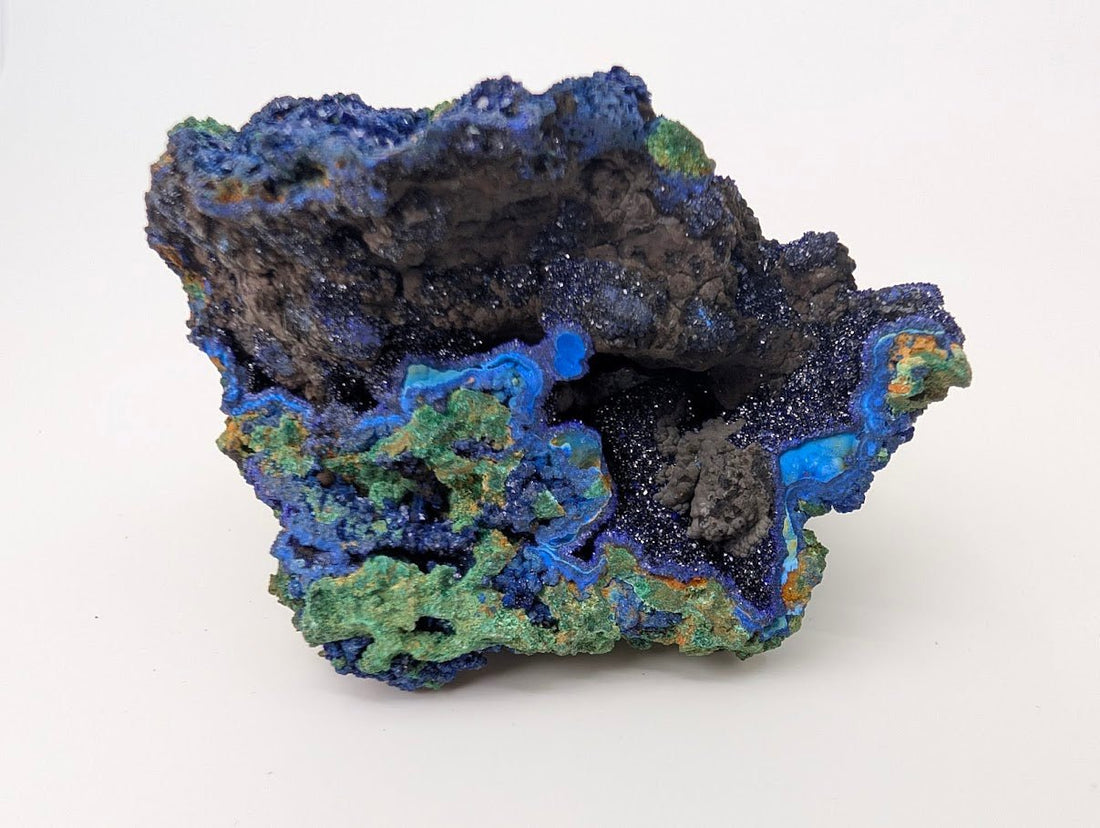
Azurite and Malachite Vugs: A Geological Marvel from Liufengshan Mine, China
Share
The world of mineral collecting is filled with extraordinary finds, but few specimens capture the imagination quite like the azurite and malachite vugs from the Liufengshan Mine in Anhui Province, China. These striking formations showcase the mesmerizing interplay of deep azure blue azurite and rich green malachite, often within open vugs—cavities in the host rock lined with crystalline formations. Their vibrant colors, intricate textures, and storied geological history make them prized specimens for collectors and enthusiasts alike.
The History of the Liufengshan Mine: A Legacy of Copper and Minerals
The Liufengshan Mine in Anhui Province, China, has a long and storied history as one of the country’s most significant sources of copper ore and secondary copper minerals. The region itself has been an important hub for mining activities for centuries, contributing to China’s rich tradition of mineral extraction.
Early Mining and Copper Production
Historical records suggest that copper mining in Anhui Province dates back several hundred years, with early operations focused on extracting raw copper for use in tools, currency, and decorative items. As metallurgy advanced in China, copper became a crucial material in bronze production, which played a vital role in the country’s early civilization.
The Liufengshan Mine became a recognized mining site during the 20th century, when industrial-scale copper extraction intensified to support China's growing demand for metals in construction, electronics, and manufacturing. The mine’s primary function has always been as a copper producer, with its rich ore deposits supplying the region’s smelting and refining industries.
Discovery of Secondary Copper Minerals
While copper extraction remained the mine’s core focus, the discovery of vibrant azurite and malachite specimens in the oxidation zones of the deposit marked an exciting development for mineral collectors and geologists. The oxidation process within the mine's copper ore bodies led to the formation of spectacular secondary minerals, particularly in underground vugs where groundwater facilitated dissolution and recrystallization over millions of years.
By the late 20th century, as mineral collecting gained popularity worldwide, specimens from the Liufengshan Mine began appearing in international markets. Collectors marveled at the deep blue azurite clusters, velvety green malachite formations, and vugs lined with sparkling copper carbonate crystals, making these specimens highly desirable.
The Rise of Liufengshan as a Collector’s Source
During the 1990s and early 2000s, Chinese mineral specimens—particularly azurite, malachite, fluorite, and quartz—started to gain international recognition. Dealers and collectors began sourcing high-grade mineral specimens from Chinese mines, with the Liufengshan Mine quickly becoming known as a premium locality for azurite and malachite.
One of the factors that set Liufengshan apart was the exceptional quality and size of its vug-lined formations. Unlike some mines where azurite forms in compact masses, the Liufengshan Mine produced open vugs with well-formed, high-luster crystals, making them particularly valuable for collectors.
Modern-Day Mining and Specimen Availability
Today, the Liufengshan Mine continues to be an active copper mining operation, with mineral specimens being a secondary yet significant byproduct of the extraction process. As mining depths increase and oxidation zones become less accessible, high-quality azurite and malachite vugs from the mine are becoming increasingly rare.
Many of the finest Liufengshan specimens were collected in past decades, meaning that new finds are becoming less frequent. This scarcity has driven up demand, especially for larger vugs with well-preserved azurite crystals or transitional specimens showcasing azurite-to-malachite conversion.
Azurite and Malachite: A Stunning Transformation
Azurite (Cu₃(CO₃)₂(OH)₂)
Azurite is a copper carbonate hydroxide mineral prized for its deep blue hue, a result of its copper content absorbing light at specific wavelengths. It typically crystallizes in the monoclinic system, forming prismatic or tabular crystals with a vitreous luster. In specimens from the Liufengshan Mine, azurite often appears in dense, sparkling crystal clusters, filling vugs within the host rock.
Malachite (Cu₂CO₃(OH)₂)
Malachite, a close relative of azurite, forms when azurite undergoes a chemical transformation due to increased oxidation. This process replaces some of the carbon dioxide in azurite’s structure with water, yielding malachite’s signature vivid green hue and botryoidal or fibrous formations. At the Liufengshan Mine, this transformation can occur gradually, leading to specimens where azurite and malachite intergrow seamlessly, creating mesmerizing contrasts of color and texture.
What Makes Liufengshan Vugs Special?
-
Intense Color Contrasts: Striking blue azurite paired with rich green malachite creates a stunning visual effect.
-
Perfectly Formed Vugs: Open cavities lined with fully developed crystal formations.
-
Exceptional Clarity and Structure: High-luster crystals with well-defined terminations.
-
Rare Transitional Specimens: Unique azurite-to-malachite transformation pieces offer insight into mineralogical evolution.
Metaphysical Significance
Azurite and malachite are believed to have powerful energetic properties:
-
Azurite: Enhances intuition, deepens meditation, and fosters higher consciousness.
-
Malachite: Absorbs negative energies and promotes emotional healing.
-
Combined Energies: The two minerals together create a synergy of spiritual insight and grounding protection.
Collectibility and Value
The Liufengshan Mine’s azurite and malachite vugs are becoming increasingly sought-after due to their scarcity and exceptional quality.
-
Larger vugs with dense crystal coverage are rare and command premium prices.
-
Specimens featuring azurite-to-malachite conversion are highly desirable.
-
High-quality Liufengshan pieces rival those from Bisbee, Arizona, and Touissit, Morocco.
Displaying and Caring for Azurite and Malachite Vugs
-
Avoid prolonged exposure to direct sunlight (prevents azurite from fading).
-
Keep humidity levels moderate (malachite is slightly porous).
-
Handle with care (both minerals are relatively soft and fragile).
-
Use indirect lighting to enhance color vibrancy.
Final Thoughts: A Must-Have for Collectors
The Liufengshan Mine’s azurite and malachite vugs represent a stunning fusion of geology and artistry. Whether admired for their scientific intrigue, aesthetic appeal, or spiritual energy, these specimens embody nature’s ability to create masterpieces in stone.
If you’re looking for a truly unique addition to your collection, an azurite-malachite vug from the Liufengshan Mine is an investment worth making!



